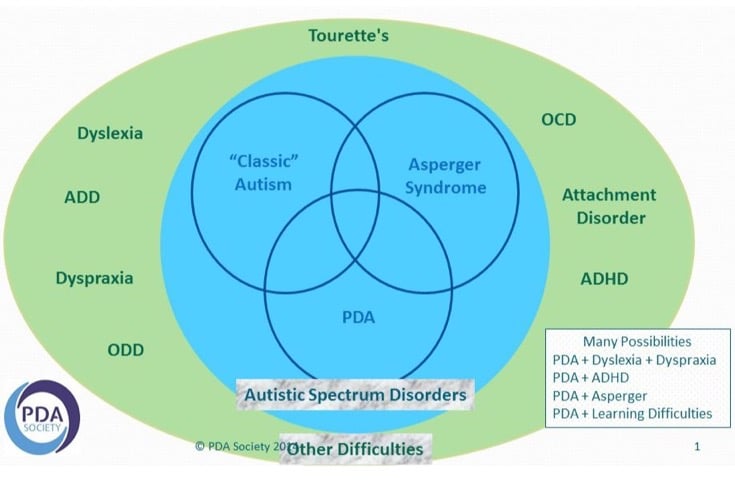Demand
Pathological Demand Avoidance (PDA)
11/09/18 11:47
Pathological Demand Avoidance in Adults
What is Pathological Demand Avoidance?
People with Pathological Demand Avoidance or PDA are driven to avoid demands due to their high anxiety levels when they feel that they are not in control.
PDA is increasingly recognised as being part of the autism spectrum. Some psychologists refer to it as a diagnostic profile or sub-type within autism. Individuals with PDA share difficulties with others on the autism spectrum in terms of social aspects of interaction and communication, together with some repetitive behaviour patterns. However, people with PDA often seem to have better social understanding than others on the spectrum
In individuals with PDA, their avoidance is clinically-significant in its extent and extreme nature. Children and adults with PDA can also mask their difficulties, and their behaviour can vary between settings.
PDA is a relatively new diagnosis it is frequently confused with Oppositional Defiant Disorder (ODD) as a diagnosis. PDA as shown in the diagram below from the PDA Society (www.pdasociety.org.uk) PDA falls within the circle of Autistic Spectrum Disorders, whereas ODD does not. There other conditions with frequently cooccur with autism in the green circle.

Figure 1: Pathological Demand Avoidance and its Interplay with Autism
Please note that Asperger Syndrome is now referred to as High Functioning Autism (HFA), although there is still some dispute that they are separate conditions.
There is overlap between most of these diagnoses. The term 'can't help won't' is often used to describe PDA.
PDA Not Yet Recognised in the DSM-5 and ICD-10
Many people are diagnosed with PDA as a condition in its own right. Presumably, this is because they do not meet the full diagnostic criteria for Autism Spectrum disorder ASD. The problem with this approach is that:▪ PDA is not included in the Diagnostic and Statistical Manual - fifth edition (DSM-5)
▪ PDA is not included in the International Classification of Diseases - 10th Edition (ICD-10)
Consequently, if the condition does not appear in the leading diagnostic manuals for psychological conditions some schools and educational institutions may find it difficult to provide support. Many argue that every individual with PDA is autistic.
PDA as a Form of Autism Spectrum Disorder
It is becoming more common for people to receive a diagnosis of ‘Autism Spectrum Disorder (ASD) characterised by extreme demand avoidance.’ Alternatives ways of putting the diagnosis are:
ASD with a PDA profile;
ASD sub-type PDA; or
Atypical autism with demand avoidant tendencies.
Learn more about the key Characteristics of Pathological Demand Avoidance
6 Main Characteristics Pathological Demand Avoidance Are:
Resisting and avoiding the ordinary demands of life;
Using social strategies as part of the avoidance;
Appearing sociable on the surface but lacking depth in their understanding;
Excessive mood swings and impulsivity;
Being comfortable in role play and pretence, sometimes to an extreme extent and often in a controlling fashion; and
Obsessive’ behaviour that is often focused on other people, which can make relationships very tricky.
Individuals with PDA have Many Positive Characteristics
One should not lose sight of the fact that individuals with PDA can be quite positive and have many strengths. They can interact well socially and can be quite talkative. They are said to have charm and can be warm and affectionate. Their need to take control means that they are often seen as quite determined. They can have a rich imagination and are frequently described as creative and passionate.
8 Top Tips on How to Support Individuals with Pathological Demand Avoidance
Pathological Demand Avoidance Treatment
1. Flexibility
Always make sure that your day activities are flexible, the the individual with PDA child might not want to do them in a particular order they might want to do it in a completely different order. Allow that flexibility and you will find that the individual with PDA will be able to cope with the anxieties of the day a lot easier.
2. Control.
People with PDA need to feel so they are in control like autism, and other ASDs anxiety rules the day for them if they do not feel in control of a situation the sense of anxiety rises and then they feel panicky and fearsome of what is going to happen; particularly when it comes to change for PDA individual the fear of not being in control generates a resistance to what if the change or a request you might want them to do something they might not be able to do or not want to do it because they might get it wrong.
3. Ease Anxiety.
If changes needed, then talk the PDA individual through it you might want to talk to them you might want to write it down in steps like bullet points or you could use images or pictures either way show the PDA individual that there is a beginning a middle and the end of a request or activity you want them to carry out; this will ease the anxiety for the individual
4. Unravel the Fear
PDA individuals often see the worst in every situation they will always think of the worst thing that could possibly happen; reassure the PDA individual that there is nothing to worry about - do not be confrontational.
5. Building up Self Confidence
A lot of PDA individuals have a problem with self-esteem and confidence they think that if they do whatever it is they are being asked to do they are not going to do it properly; it might be that they feel they will be laughed at. They might feel embarrassed. There is a huge amount of anxiety that is behind these inner fears the best thing to do is boost up PDA individual’s confidence tell them exactly what they get right, tell them what they are good at.
6. Make the change outcome beneficial
Help the person with PDA see that the change out is beneficial to them, and not to you. The key here is to make them feel that they are making the decision themselves, make them think that actually the decision is their decision. Always make the outcome look beneficial to them and not to you.
7. Provide a Responsibility
We know that people with PDA love to be in control of their own world given the responsibility to do something to help themselves this will make them feel as though they are completely in control of their being and their body and, therefore, the outcome. The secret to it is careful wording in the request do not bark an order at them but suggest a way of doing something and add the element of responsibility into that request so they feel as though they are doing something for themselves.
8. Set boundaries
People with PDA need to know there will be a beginning a middle and an end. Help them to think what it will be like to achieve the end result. Provide them with a sense of responsibility.
Learn More About Pathological Avoidance Syndrome
What is Pathological Demand Avoidance?
Pathological Demand Avoidance
Pathological Demand Avoidance – One Family's Story
Pathological Demand Avoidance: Behavioural Strategies
